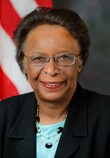Remarks

Dr. Cora Marrett
Deputy Director
National Science Foundation
Biography
Celebrating the GRF 60th Anniversary and Announcement
of GRFP Video Contest Winners and
Announcement of Graduate Research Opportunities Worldwide (GROW)
NSF Signature Program for Graduate Students Then and Now
Stafford I, Room 375
December 5, 2012
I am delighted to share in the celebration of the 60th Anniversary of the Graduate Research Fellowship Program (GRFP), NSF's signature program.
The GRFP is our country's oldest fellowship program directly supporting graduate students in science, technology, engineering and mathematics (STEM) fields. Over 60 years, the program has changed in some respects. But the excellence of the fellows -- evident in their achievements before, during and after their awards -- remain unchanged.
We often think of our GRFs as supporting the best and brightest in science and engineering, but how often do we think of them as advocates to recruit future generations?
- Yet, we have as an example Aimee Bryan, a fellow in chemistry and self-professed ""Mad Scientist" at the University of California at Davis. Aimee's research examines the magnetic properties of new compounds. She says her GRF has let her focus on her research, and also has given her the time to convince young people that science is a potential career path.
As a volunteer, Aimee launched a Science Club for K-12 students and their families, which meets monthly at a donated school lab. More than 80 families have joined and more come every time. "Some of the kids come in thinking science is boring and I tell them it's no different than cooking but you can't eat your products," she told us. Club meetings include hands-on science conducted by guest scientists in fields such as forensics, etymology, the engineering of rockets and ornithology. Aimee is now working on bringing in a firefighter to explain the physics behind what she does.
We should also remember that a GRF is a seal of approval from the NSF, and a builder of confidence.
- The experiences of Julia Bursten serve to illustrate. Julia came from the University of Pittsburgh to join us today. Julia says the GRF gave her the support and the spark that she needed to keep moving forward when things got hard.
"Even after I received my GRF, I was still unsure what shape my research would take. So I went to a chemistry professor and asked if I could sit in on the class. When I said I was a GRF, I was not only asked to sit in, I found a new member for my dissertation committee," Julia told us.
"The GRF was the key to unlock a whole bunch of doors that I wouldn't have been brave enough to knock on. With the GRF, I had the credential to go out and talk to scientists and be taken seriously."
The enthusiasm of fellows marks more than these two careers. I had an opportunity to learn more about our signature program when I visited the University of Illinois recently. The fellows on the campus were assembled for the first time, to comment on their experiences. They lauded and they praised their experience while offering suggestions for even greater advances to the program. As we were concluding, university officials told me how valuable the experience of hearing from all the fellows had been and promised to bring them together again.
The Graduate Research Fellowship Program began in 1952, the first year the National Science Foundation was funded. Sixty years ago, 3,000 promising young scientists and engineers applied for graduate research fellowships:
- 569 awards were made to pre-doctoral graduate students from the United States, its territories and to American citizens abroad.
- 32 were women
- GRFs received $1,400 for year one, $1,600 for year two, and $1,700 for year three.
- Most were notified by telegram.
Today. . .GRF 2013
- Over 13,000 GRF applications were submitted in the most recent round
- Many applicants were women and from underrepresented minority groups
- 2,000 GRFs will be given, pending budget approvals
- Annual stipends will be $30,000, with a $2,000 annual raise pending in Congress.
- Most GRFs found out by email.
This record could not have been achieved without extraordinary applicants and an incomparable staff. The dedication of the staff to managing an extremely complex program, to updating fellows on recent developments, and to oversight of the program is admirable.
At this juncture, I'd like to ask all the current GRFs here with us today to please stand. I make the same request of the people who have managed or still manage the program. Let's give them a round of applause, so they know how appreciated they are.


